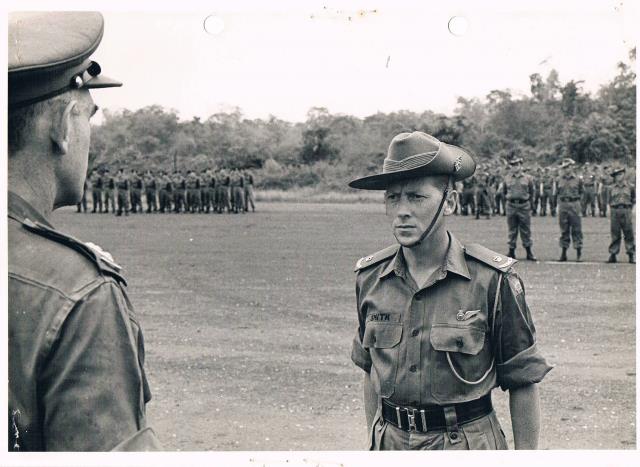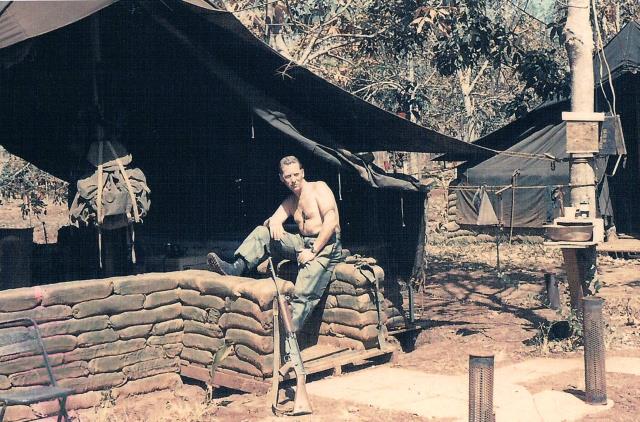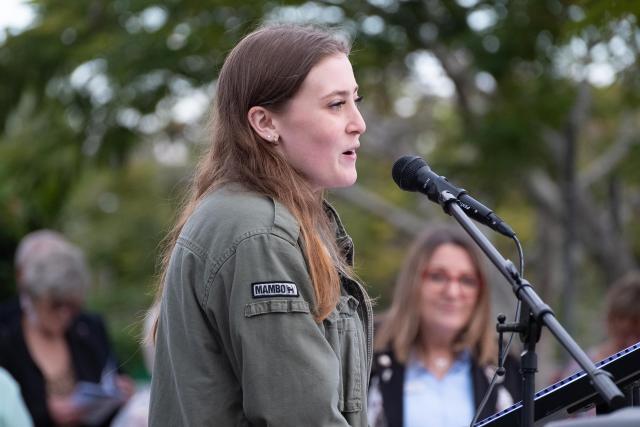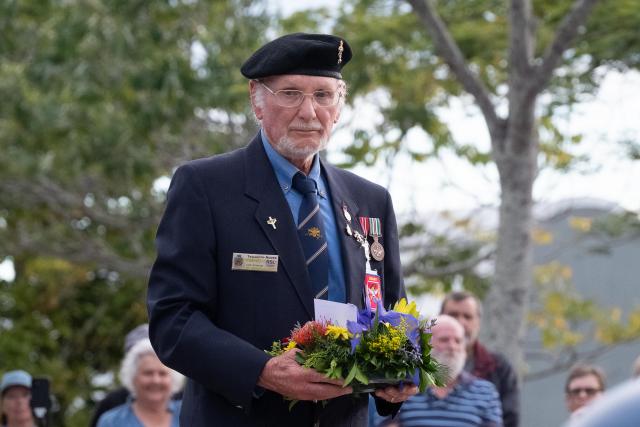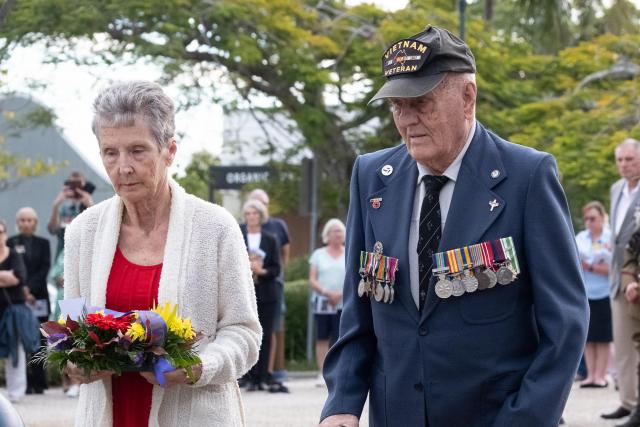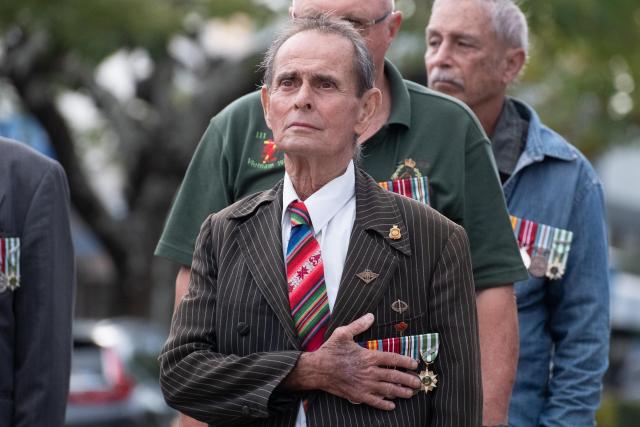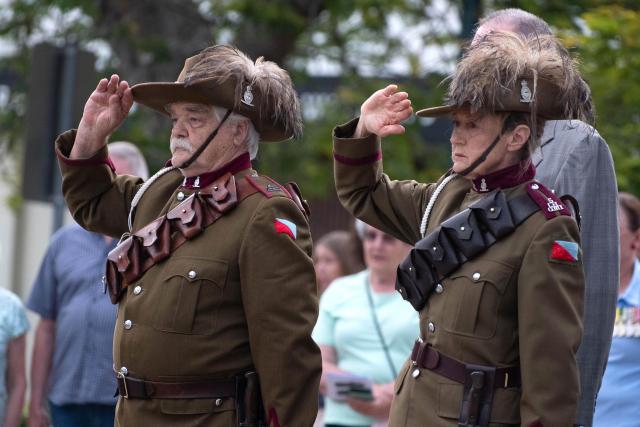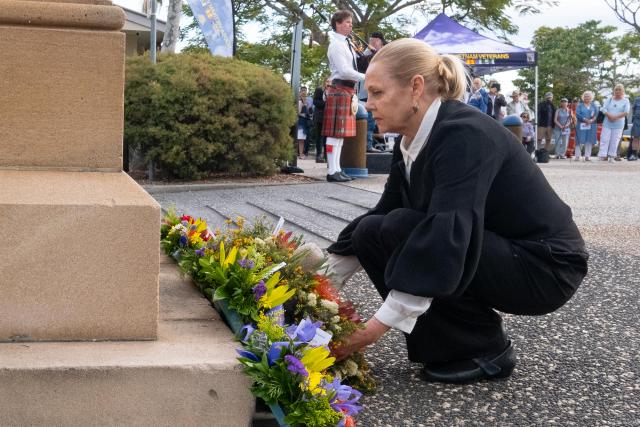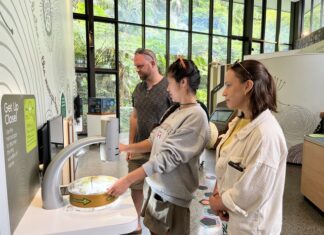When Tewantin Noosa RSL sub branch celebrated the 50th anniversary of the end of Australia’s involvement in the Vietnam War, newly-elected president Clinton Ware said he hoped the auspicious occasion would be a “day of remembrance, reflection, memories, a little sadness, a lot of laughs and stories with old mates over a few drinks”.
The occasion was marked in Tewantin with a parade and commemoration service on Vietnam Veterans Day, held as it is each year, on the anniversary on 18 August of the war’s most famous battle of Long Tan in 1966.
During the ceremony MC Graham Prattle introduced Clinton Ware, recounting his extensive military career.
“Clinton joined the navy in 1982 at age of 15. He completed two years in navy as a sonar operator on HMAS Parramatta, then transferred to the Army in 1984 and served in air dispatch 176 squadron as group commander in paratrooper infantry. He served in various other units including SAS, commando and two Lighthouse regiment mounted infantry. He was deployed to Somalia, Rwanda, East Timor, Afghanistan and Iraq. He reached the rank of sergeant and was discharged from the army in 2004,” he said.
Clinton paid tribute to the event’s special guest, his father Edward (Ted) Ware who attended with his wife, Diana.
Ted Ware, who was born in 1935 in Rawalpindi, India, the son of the RSM Royal Hampshire Regt. (The Fighting Tiger), enlisted in the Royal Air Force in 1951, aged 16.
After arriving in Australia with his wife Diana, Ted was posted to RAAF Base Edinburgh and deployed to South Vietnam in 1968 with 1 Operational Support Unit as a comms operator/telegraphist. Ted was stationed in Vung Tau and Nui Dat on rotation and returned to his family in 1969.
He has now retired in Bundaberg.
RSL member Dean Harlow described the battle of Long Tan, recalling it as the largest loss of life of a single day’s war in Australia, before reading out the names of the fallen at the battle: Pte Richard Aldersea, Cpl Peter Clements, Pte Glenn Drabble, Pte Kenneth Gant, Pte Ernest Grant, Pte Victor Grice, Pte James Houston, P/Cpl Jack Jewry, Pte Paul Large, Pte A McCormack, Pte Dennis McCormack, Pte Warren Mitchell, Pte Douglas Salverton, 2Lt Gordon Sharp, Pte David Thomas, Pte Francis Topp, Pte Maxwell Wales and Pte Colin Whiston.
Australian Army Lieutenant Colonel Harry Smith was the commanding officer of the battle of Long Tan.
When a film of the event, titled Danger Close: the battle of Long Tan, was released four years ago, Smith, then aged 86, spoke to Noosa Today from his Mudjimba home about the events of that day, recalling the battle as though it had occurred the day before.
Smith, 33 at the time, and his men of Delta Company 6th Battalion Royal Australian Regiment (6RAR) were based at the Australian stronghold of Nui Dat, in the middle of Viet Cong supply route when about 2am on 17 August the base was targeted by mortars and rocket launchers.
The next morning B Company 6RAR led by Major Noel Ford was told to “go out and see what they could find”.
They found base plates from the mortars and empty rocket launches but no sign of the enemy, Smith said.
The commanding officer (Brigadier Oliver Jackson) called them in.
“We took over from them. We had 105 in the company and three (Royal) New Zealand artillery control team led by (Captain) Morrie Stanley who travelled alongside me,” Smith said
There were three platoons – 10 led by Lieutenant Geoff Kendall, 11 led by Lieutenant Gordon Sharp, and 12 with Smith under Smith’s control.
“What we didn’t know was that a regiment of North Vietnam troops (with more than 2000 men) had come in during the week and were hiding in the jungle (the other side of a rubber plantation, about 5km from the base).
They came across a few enemy and “knocked one over”. The wounded man was carried off to the east toward the rubber (plantation). When radio contact told them the enemy had come in contact with 11 Platoon there were 30-40 of them. That quickly built up to hundreds.
“I had to get 11 platoon out. They had lost 13 men and a couple were injured. The enemy had built up to about 1000.
Smith called for reinforcements but it was held back as the Brigadier thought the base was under threat of attack.
Smith later found out the Brigadier had been informed 2000 enemy had travelled to the east on 14 August and were waiting to attack on the night of the concert being given by Australian singers Col Joye and Little Pattie.
“The concert was going on. We could hear the music when we were going out,” Smith said.
Smith managed to get his platoon into a position below a rise out of sight and below firing range from the enemy. The remaining members of 11 platoon later managed to join them.
As the battle exploded so did the monsoons bringing down intense rain, thunder and lightning and reducing visibility.
Stanley provided enemy locations to Allied Artillery forces at Nui Dat which responded with 3500 rounds of fire.
“That’s a lot of explosives”, Smith said.
“It held the enemy down but they kept on coming (over the rise). Our frontline gunners had machine guns. They mowed them down.”
With ammunition running out two daring helicopter pilots flew through the atrocious weather to drop them supplies.
“Not one enemy got into our lines,” Smith said.
“The enemy took so many casualties. They decided to withdraw at 6.45pm as darkness was falling, and as the armed personnel carriers were coming in (an hour and a half after reinforcements were requested). It was all over then. There was not another shot fired.”
“We went back the next morning. It was a scene of carnage. It’s a scene I can still recall.
“We looked on all the rubber (trees) and all we could see was blood. We found 245 enemy dead. There were 48 more we found in a mass grave to the east.
“In 1969 an underground hospital was found. In it they found the names of all the enemy lost at Long Tan. There were 876 left on the battlefield or died from injuries.”
At the 50th anniversary of the battle Smith travelled to Vietnam and spoke to Vietnamese who fought as enemy in the battle.
They couldn’t believe they were up against 100 soldiers, he said.
“On 20 August the commanding officer called saying there was hell to pay (in Australia) over our servicemen being killed and to offset it with gallantry awards.
Smith drew up a list of 20 worthy recipients only to be told he had too many. The number was cut in half and the awards downgraded.
At the time awards were rationed to a maximum of one medal for every 250 soldiers each six months.
Smith was awarded the Military Cross while the Distinguished Service Order was presented to the Brigadier who never left his office in Nui Dat, he said.
In 1968 members of Delta 6RAR were awarded the US Presidential Unit Citation for gallantry by US President Lyndon B Johnson for extraordinary heroism in action against an armed enemy. South Vietnam awarded them the equivalent.
Smith had to wait till after the 30 year-secrecy period to publicly access military information before he set about fighting to gain recognition for his men in Australia.
In 2016, following a tribunal, Smith’s recommendations for awards were finally approved.
Smith commemorates the anniversary of the battle each year, lays a wreath and has lunch at the RSL with other Long Tan veterans.
“I try to let it go at other times,” he said.
Smith said he felt “very sad about the 17 soldiers (and one army corp man) we lost. I feel sad for all the Vietnamese soldiers. Some of them were just teenagers,” he said.
“Most of my men were conscripts. They were conscripts at 20 and 21 in Vietnam. They were excellent soldiers.”
It was only through their outstanding gallantry and bravery that they survived Long Tan, he said.

